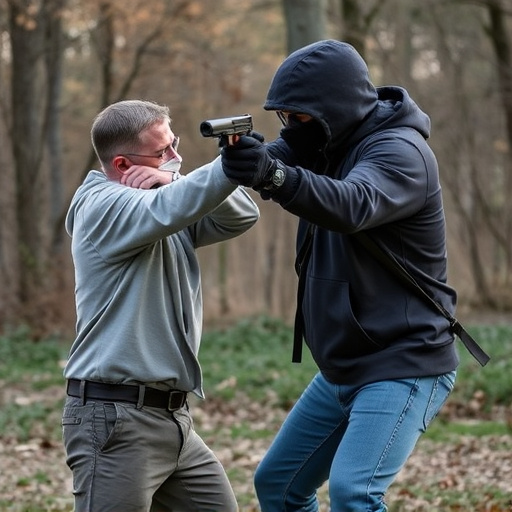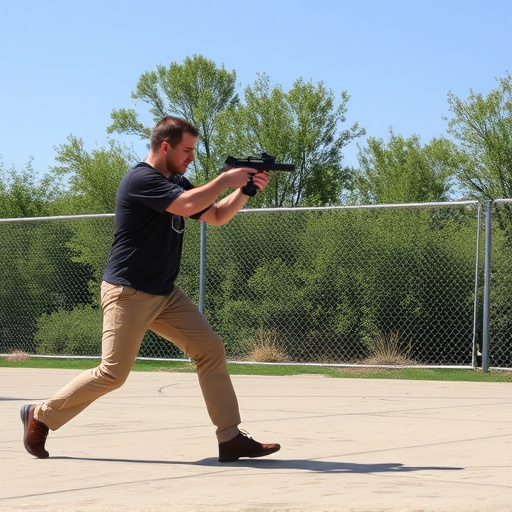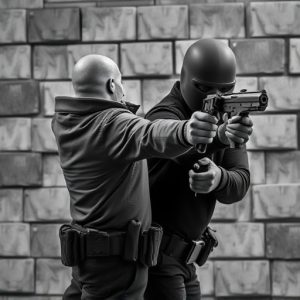Non-Lethal Weapons Training: Unlocking Safe Usage and Real-World Applications
Non-lethal weapons, particularly stun guns, have gained prominence in law enforcement for de-escalat…….
Non-lethal weapons, particularly stun guns, have gained prominence in law enforcement for de-escalating dangerous situations without causing permanent harm. Stun guns deliver a high-voltage electrical current that disrupts the nervous system, leading to temporary muscle paralysis and disorientation. Proper training is crucial for safe and effective deployment, emphasizing responsible use and minimizing potential harm. In real-world applications, stun guns play a critical role in controlling individuals without causing permanent damage through specific impacts on the nervous system. However, their ethical and legal application remains a developing concern, with law enforcement officers needing comprehensive training to balance public safety and individual rights.
“Unleashing control without causing harm: that’s the promise of non-lethal weapon training, particularly focusing on stun guns. This comprehensive guide delves into the evolving world of non-lethal force, exploring its effectiveness and safety. From understanding the intricate science behind stun gun technology—how they manipulate the nervous system—to navigating certification processes and real-world applications, this article is your key to unlocking the intricacies of responsible non-lethal weapon usage.
Discover how these tools are shaping modern law enforcement, all while considering ethical implications and legal boundaries related to their deployment.”
- Understanding Non-Lethal Weapons: A Comprehensive Overview
- The Science Behind Stun Guns: How They Affect the Nervous System
- Certification Process: Unlocking the Secrets of Safe Usage
- Real-World Applications: Scenarios for Non-Lethal Force
- Legal Considerations and Ethical Use in Modern Law Enforcement
Understanding Non-Lethal Weapons: A Comprehensive Overview

Non-lethal weapons, also known as less-lethal tools or alternatives to firearms, are designed to incapacitate or control individuals without causing permanent or life-threatening injuries. These weapons have become increasingly important in law enforcement and security operations worldwide due to their potential to de-escalate potentially dangerous situations. One of the most common types is the stun gun, which utilizes high voltage electrical current to disrupt the nervous system, causing temporary muscle paralysis and disorientation.
The effects of a stun gun on the nervous system are quick and powerful. When activated, the device delivers a strong electric shock that interferes with the body’s normal electrical signals, specifically targeting the muscles and nerves. This interference leads to muscular contractions, disorientation, and loss of balance, rendering the target temporarily disabled. Unlike firearms, non-lethal weapons like stun guns are meant to incapacitate rather than kill, making them valuable tools for police officers in crowd control, arrest, and self-defense scenarios.
The Science Behind Stun Guns: How They Affect the Nervous System

Stun guns, also known as electronic control devices (ECDs), operate by delivering a high-voltage, low-current electrical pulse to disrupt the nervous system. This disruption causes muscular paralysis and disorientation in the target, enabling the user to subdue them temporarily. The specific mechanism involves the discharge of an electric current through two metal probes or electrodes that make contact with the body. This electrical impulse interferes with the transmission of nerve signals, specifically targeting motor neurons responsible for muscle contraction. As a result, muscles become flaccid and the individual experiences a loss of balance and coordination, providing an opportunity to gain control and de-escalate the situation safely.
The effects on the nervous system are designed to be non-lethal and reversible. The electrical pulse is not strong enough to cause permanent damage or cardiac arrest, unlike traditional firearms. However, it can lead to temporary neurological consequences such as memory lapses, disorientation, and in rare cases, longer-lasting sensory impairments if the stun gun is misused or used inappropriately. Understanding these effects is crucial for individuals undergoing non-lethal weapon training certification, as it emphasizes the importance of proper technique and responsible use to ensure safety and minimize potential harm.
Certification Process: Unlocking the Secrets of Safe Usage

The certification process for non-lethal weapon training, such as stun gun use, is designed to unlock the secrets of safe and effective deployment. It involves rigorous training in both theoretical knowledge and practical application. Trainees learn about the precise effects of stun guns on the nervous system, understanding how these devices disrupt muscle control without causing permanent damage. This knowledge equips individuals to make split-second decisions in potentially dangerous situations, ensuring their safety and that of others.
The process includes hands-on practice with various models, allowing trainees to experience firsthand the range of stun gun capabilities. Instructors emphasize safe handling procedures, de-escalation techniques, and legal considerations surrounding self-defense. By mastering these skills, individuals not only gain a valuable certification but also become responsible guardians capable of diffusing high-stress encounters without resorting to lethal force.
Real-World Applications: Scenarios for Non-Lethal Force

In real-world scenarios, non-lethal weapons, such as stun guns, are deployed to subdue and control individuals without causing permanent harm. These tools have proven invaluable in various contexts, from law enforcement operations to crowd control during public events. When a stun gun delivers its electric shock, it disrupts the nervous system, temporarily paralyzing muscles and rendering the target immobile. This effect allows officers or trained professionals to gain control of potentially dangerous situations, enabling them to restrain individuals who may be under the influence, agitated, or aggressive.
The application of non-lethal force is carefully considered and typically employed as a last resort when conventional methods fail or are inappropriate. Scenarios include disarming a suspect without escalating violence, controlling unruly crowds, or managing distressed individuals who pose a risk to themselves or others. Understanding the specific effects of stun guns on the nervous system and their role in de-escalation techniques is crucial for certification training, ensuring professionals can make informed decisions in high-pressure situations.
Legal Considerations and Ethical Use in Modern Law Enforcement

In modern law enforcement, the ethical and legal use of non-lethal weapons is a complex and evolving field. As technology advances, new tools like stun guns, also known as electroshock weapons, have emerged with claimed effects on the nervous system, temporarily incapacitating individuals (Stun Gun Effects on Nervous System). However, these devices raise significant ethical questions regarding their potential for overuse or misuse, particularly in high-stress situations.
Legal considerations play a crucial role in dictating how and when these weapons can be employed. Many jurisdictions have specific regulations and guidelines governing the use of non-lethal force, emphasizing proportionality and necessity. Law enforcement agencies must ensure that officers receive comprehensive training on these weapons’ safe and effective deployment to balance public safety with respect for individual rights and freedoms.
In conclusion, non-lethal weapon training certification equips individuals with the knowledge and skills necessary to deploy stun guns effectively while minimising harm. Understanding the science behind these devices, such as their effects on the nervous system, is crucial for safe and ethical use. By navigating the certification process, professionals can ensure they are prepared for real-world scenarios that require non-lethal force, all while adhering to legal and ethical considerations in modern law enforcement.


